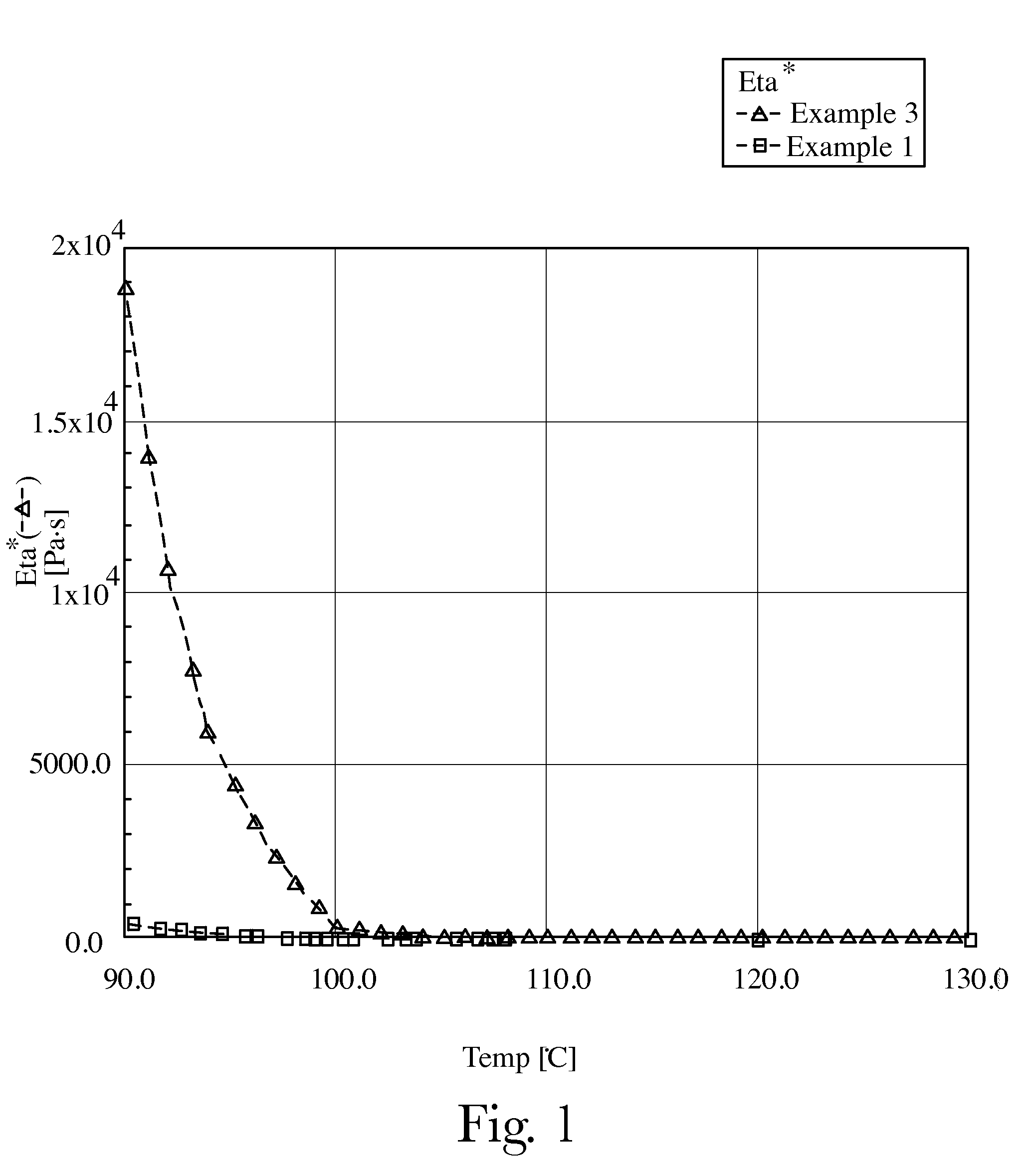Hot melt adhesive composition
a technology of hot melt adhesives and compositions, applied in the direction of petroleum chemical modification, application, impression caps, etc., can solve the problems of poor cohesion, poor elongation at break, and poor adhesion of acetate copolymer-based hot melt adhesives, etc., to achieve high cohesion, lower viscosity, and high viscosity
- Summary
- Abstract
- Description
- Claims
- Application Information
AI Technical Summary
Benefits of technology
Problems solved by technology
Method used
Image
Examples
example 1
Adhesive Compositions and Properties
Materials:
[0052]The following raw materials were compounded according to the present invention (bw=by weight):
Escorene UL 15019 CC16.00% bwEscorene MV 2528 EH216.00% bwSylvalite RE100 L50.00% bwNytex 28010.00% bwVestowax H2050 7.90% bwHostanox 1010 0.10% bw
[0053]Escorene UL 15019 CC is an ethylene vinyl acetate copolymer, available from Exxon Mobil, characterized by a vinyl acetate content of 19% by weight and a melt viscosity at 150° C. of 262 Pascals.
[0054]Escorene MV 2528 EH2 is an ethylene vinyl acetate copolymer, available from Exxon Mobil, characterized by a vinyl acetate content of 28% by weight and a melt viscosity at 150° C. of 9.6 Pascals.
[0055]Sylvalite RE100 L is a Rosin Ester tackifier, available from Arizona Co. characterized by a softening point of 100° C.
[0056]Nytex 820 is a plasticizing naphthenic mineral oil available from Nynas Co.
[0057]Vestowax H2050 is a synthetic Fischer-Tropsch wax available from Evonik Degussa having a drop...
example 2
Comparative Example
[0067]The same ingredients used in Example 1 were compounded according to formulation criteria similar to that taught by the Prior Art. The procedure for making the composition is the same as the procedure described above. In particular, a higher amount of wax was used according to the following formulation:
Escorene UL 15019 CC16.95% bwEscorene MV 2528 EH216.95% bwSylvalite RE100 L33.00% bwNytex 28016.50% bwVestowax H205016.50% bwHostanox 1010 0.10% bw
[0068]The formulation showed the following properties:
[0069]Viscosity at 120° C.=2800 mPascals per second
[0070]Elongation at break=30%
[0071]Energy for breaking=53 mJoules
[0072]Creep Time=40 seconds
[0073]Eta(90)−Eta(130) / (130−90)=9.39
[0074]T-peel film to film=14 g / inch
[0075]T-peel film to nonwoven=34 g / inch
[0076]Those skilled in the art of making hygienic articles will recognize that the foregoing properties are unsatisfactory for cohesion and lower adhesion, especially on film. In particular, an adhesion of only 14 g...
example 3
Comparative Example
[0077]The following ingredients have been compounded not using any plasticizing oil according to the following formula:
Escorene UL 15019 CC25.00% bwEscorene MV 2528 EH215.00% bwYT 31449.90% bwVestowax H205010.00% bwHostanox 1010 0.10% bw
[0078]YT 314 is a Rosin ester tackifier available from Euro-Yser Company and characterized by a softening point of 94° C.
[0079]The formulation showed the following properties:
[0080]Viscosity at 120° C.=18,000 mPascals per second
[0081]Elongation at break=234%
[0082]Energy for breaking=150 mJoules
[0083]Creep Time=>4,000 seconds
[0084]Eta(90)−Eta(130) / (130−90)=470
[0085]T-peel film to film=7.6 g / inch
[0086]T-peel film to nonwoven=3.0 g / inch
[0087]The aforementioned properties show a viscosity too high for processing and very poor adhesion; particularly on nonwoven materials due to the very low penetration as outlined from the very steep slope of the curve, Viscosity vs. temperature. As shown in FIG. 1, the viscosity vs. temperature curve f...
PUM
| Property | Measurement | Unit |
|---|---|---|
| Temperature | aaaaa | aaaaa |
| Temperature | aaaaa | aaaaa |
| Temperature | aaaaa | aaaaa |
Abstract
Description
Claims
Application Information
 Login to View More
Login to View More - R&D
- Intellectual Property
- Life Sciences
- Materials
- Tech Scout
- Unparalleled Data Quality
- Higher Quality Content
- 60% Fewer Hallucinations
Browse by: Latest US Patents, China's latest patents, Technical Efficacy Thesaurus, Application Domain, Technology Topic, Popular Technical Reports.
© 2025 PatSnap. All rights reserved.Legal|Privacy policy|Modern Slavery Act Transparency Statement|Sitemap|About US| Contact US: help@patsnap.com


